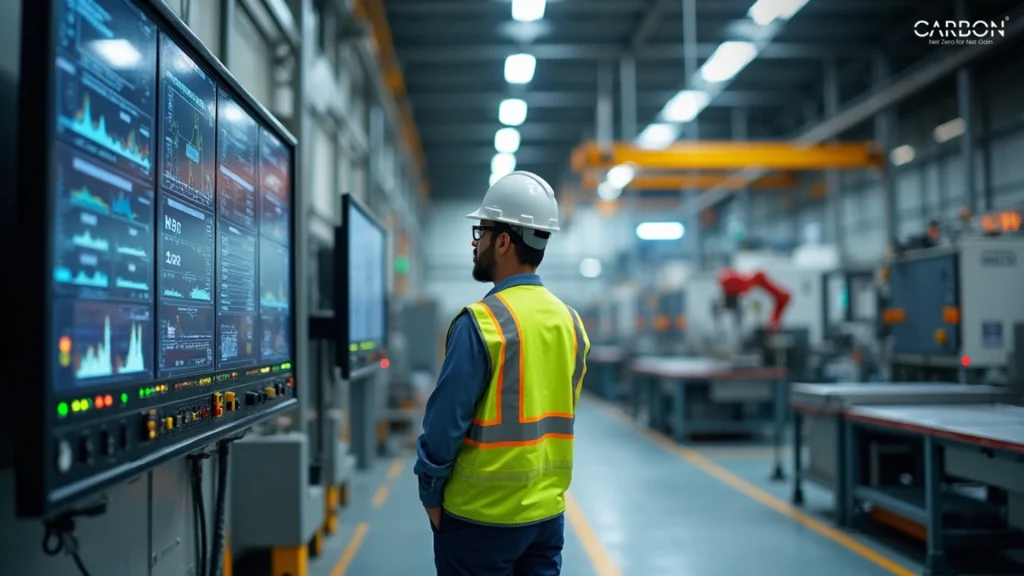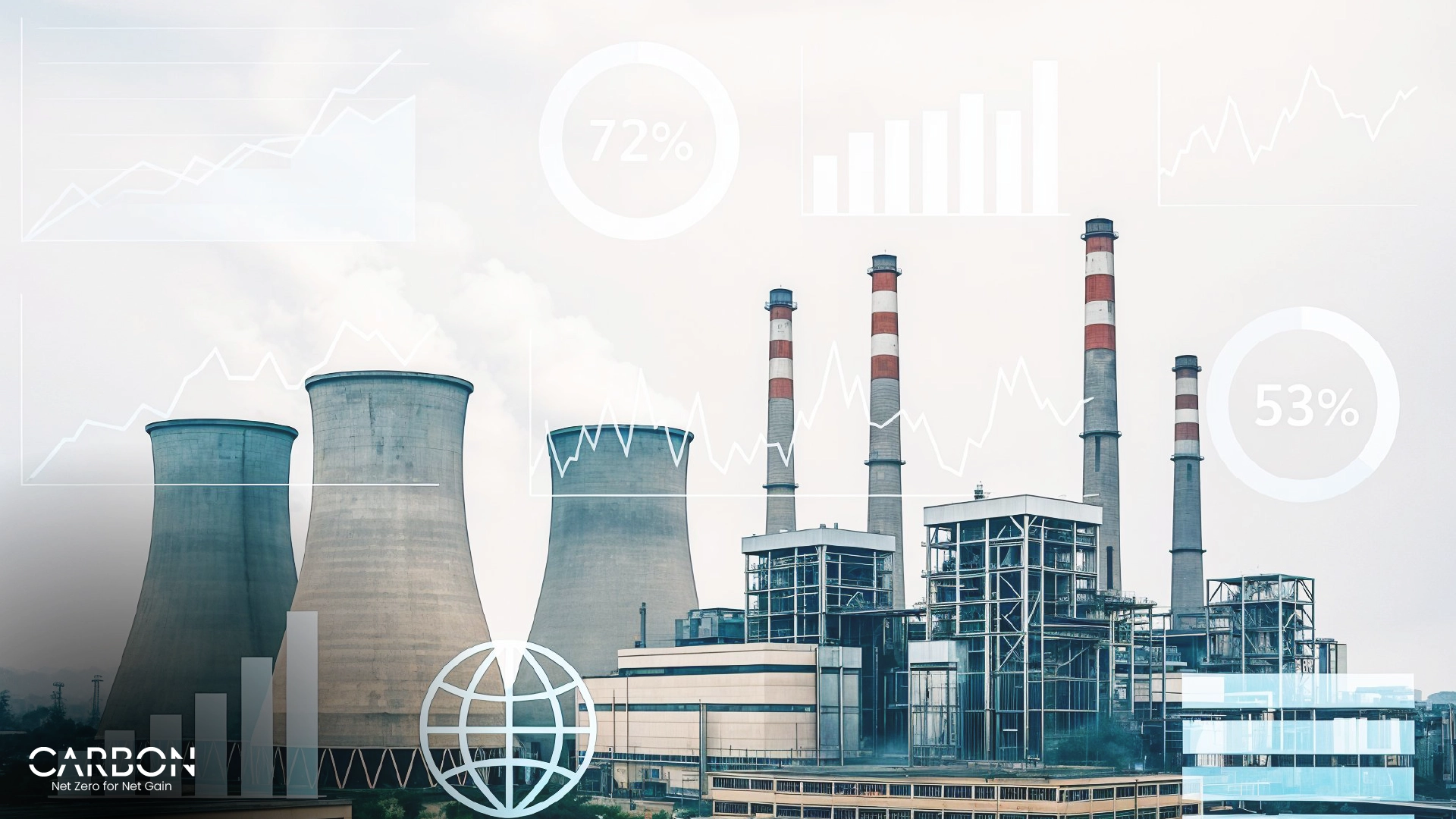Key Takeaways
Industrial energy monitoring systems offer manufacturers a powerful pathway to reduce costs while improving operational efficiency. Here are the essential insights every manufacturing leader should know:
• Energy monitoring systems can cut manufacturing costs by 8-25% through real-time visibility into consumption patterns and waste identification across industrial operations.
• Power factor correction prevents hidden utility penalties that can cost facilities thousands monthly, with payback periods as short as 6 months for correction systems.
• Predictive maintenance through power quality monitoring reduces equipment failures by up to 14% and prevents costly emergency repairs through early warning systems.
• Scalable solutions exist for all facility sizes, from single production lines to multi-site operations, with phased implementation approaches that manage initial costs.
• Integration with sustainability platforms enables streamlined compliance reporting while supporting long-term environmental goals and regulatory requirements.
You’ve seen the monthly utility bill. The number that makes you pause, blink twice, and wonder where all that energy actually went.
Now multiply that feeling across an entire manufacturing operation.
Industrial facilities burn through energy like it’s free money. Except it’s not free, and most manufacturers have no idea where it’s going. Industrial processing facilities are the largest energy consumers [13], bleeding cash through inefficiencies that stay hidden without proper monitoring.
Think of it like a leaky pipe behind your factory walls. You know something’s costing you, but without the right tools, you can’t pinpoint where or how much.
Here’s what happens when you do get visibility: Google saved $1 billion through their energy management initiatives [14]. The JW Marriott cut their energy performance by 16.5% in three years, saving $471,891 [14]. Those aren’t outliers. They’re previews of what’s possible when you stop flying blind.
Energy monitoring systems don’t just track usage. They expose where your money disappears and show you exactly how to plug the leaks [12].
The stakes keep getting higher. Energy costs are climbing. Carbon reporting requirements are tightening. And your competitors are already moving.
This guide breaks down how industrial energy management cuts manufacturing costs in 2025. You’ll see the core components that actually work, the hidden savings most manufacturers miss, and how to pick the right system for your operation. Most importantly, you’ll learn how energy metering reveals exactly where you can reduce costs and use less energy [15], building the foundation for long-term operational efficiency.
The question isn’t whether you can afford to monitor your energy usage.
It’s whether you can afford not to.
Understanding Industrial Energy Management Systems
An industrial energy management system (EMS) is mission control for your facility’s energy usage. It’s constantly collecting, analyzing, and optimizing how your factory consumes power. But here’s the difference: unlike generic energy tips you’ll find scattered across the internet, an EMS delivers structured, data-driven insights built specifically for manufacturing environments.
No guesswork. No approximations. Just real numbers from real operations.
What is an EMS and how it differs from BAS
People mix up EMS and Building Automation Systems (BAS) all the time. Here’s the reality: they’re built for different jobs.
An EMS focuses on one thing: monitoring and optimizing energy consumption, identifying savings opportunities, and improving overall efficiency [1]. It’s laser-focused on energy management and optimization.
A BAS? That’s the Swiss Army knife. It oversees and controls building systems like HVAC, lighting, security, and fire safety to ensure efficient operation and occupant comfort [1]. It encompasses a wider range of building systems and their integration [1].
The key distinction? An EMS typically overlays on existing systems without direct control functionality, instead providing detailed reports and recommendations for optimization [1]. It’s the analyst, not the operator.
Core components: hardware, software, and analytics
Every effective industrial energy monitoring system breaks down into three pieces:
Hardware: Smart meters, sensors, and gateways that collect data and process information independent of manufacturers [2]. These are your eyes and ears on the ground.
Software: Sophisticated algorithms that create rules to control energy assets according to specific needs [2]. This is the brain that makes sense of all the data.
Analytics & Interface: Platforms enabling visualization of live and historical data, KPIs, and management of energy flows [2]. This is how you actually see what’s happening.
These three components work together to turn raw energy data into actionable intelligence. Without all three, you’re just collecting numbers.
Advantages of energy management for businesses
The benefits go way beyond cutting costs. Companies achieve up to 25% savings through energy-efficient upgrades like LED lighting [4], alongside improved environmental performance through systematic monitoring and control [5].
But here’s where it gets interesting: an EMS provides real-time monitoring capabilities that help identify inefficiencies sooner, allowing for faster data-driven adjustments [4]. That’s the difference between fixing problems and preventing them.
This proactive approach prevents incidents that could harm the environment while enhancing your brand image with environmentally conscious customers [5]. What used to be a cost center becomes a competitive advantage.
Ready to see what’s possible for your operation? CarbonMinus’ Savings solutions offer specialized industrial energy management tools. Calculate your potential savings using their ROI calculator based on your industry and annual energy consumption.
The numbers don’t lie. The question is whether you’re ready to see them.
Cost-Saving Opportunities Through Energy Monitoring
Your energy bill tells you what you spent. It doesn’t tell you what you wasted.
That’s where industrial energy monitoring systems come in. They expose the hidden leaks that traditional utility readings miss completely.
Let’s break down how these systems turn cost hemorrhages into cash flow opportunities.
Reducing energy waste and utility bills
Energy waste is a silent thief in your manufacturing plant. You can’t see it, but it’s stealing from you every hour of every day.
Energy monitoring works like a security camera, catching the culprit in action. Studies show that typical users save around 8% on their monthly energy bills after installing a monitoring system [6]. But here’s the kicker: that’s just the baseline. When you pinpoint exactly which equipment draws excessive power, you can target improvements where they’ll have the biggest impact.
Here’s something that’ll make you wince: “Always On” power accounts for 23% of the average electric bill [6]. That’s money literally disappearing while you sleep. Real-time tracking lets you turn off forgotten devices and eliminate unnecessary standby power.
Immediate savings. Zero guesswork.
Avoiding penalties through power factor correction
Most manufacturers don’t realize they’re paying penalties. Hidden ones that utilities tack on when your power factor falls below their threshold—typically 0.85 or 0.9 [7].
A commercial building in Pittsburgh was unknowingly paying $1,932 monthly in power factor penalties. After installing a $12,000 power factor correction system, they achieved payback in just 6.2 months [8]. Improving power factor from 0.7 to 0.9 for a 5 MVA facility can save up to €167,000 in electricity bills annually [9].
That’s not efficiency. That’s found money.
Preventing equipment failure with power quality monitoring
Poor power quality doesn’t just hurt efficiency. It kills equipment.
Monitoring voltage unbalance reduces premature failures in AC motors by up to 14% [9]. Tracking harmonic distortion helps avoid approximately 50% of transformer life loss caused by thermal stresses from harmonic currents [9].
Beyond avoiding repair costs, quality monitoring provides early warning of potential issues. This predictive capability allows for scheduled maintenance rather than emergency repairs, significantly reducing downtime costs [10].
Emergency repairs cost more than planned maintenance. Always.
Using the ROI calculator to estimate savings
Smart manufacturers quantify potential returns before diving in. Energy ROI calculators like the one from CarbonMinus help you understand what’s possible based on your specific situation [11].
Some companies report cutting energy bills by approximately 20%, maintenance costs by 40%, and operational costs by 30% [12]. The best way to know your potential? Input your data and see the projected savings tailored to your facility.
Ready to see how much you could save? Book a Demo with CarbonMinus to get a personalized assessment of your potential energy savings.
Industry Use Cases and Real-World Impact
Enough theory. Let’s see where energy monitoring actually moves the needle.
Manufacturing: optimizing heavy machinery and processes
Manufacturing facilities eat energy for breakfast. They consume over one-third of the world’s energy despite taking up less commercial space than other sectors [13]. For these power-hungry operations, monitoring delivers immediate wins.
Take one Italian valve manufacturer. They installed an online energy monitoring system to track consumption across welding, machining, painting, and high-pressure testing [14]. The system built a detailed map of energy hot spots throughout the plant. No more guessing where the big draws were.
But here’s where it gets interesting: real-time optimization.
A European coking plant used intelligent energy management to boost electricity sales during peak market periods [15]. Their system constantly weighs the cost of buying electricity versus natural gas, optimizing power generation on the fly. That’s not just efficiency. That’s turning energy management into a profit center.
Data centers: managing cooling and uptime
Data centers face a unique problem: cooling costs almost as much as the computing itself. Energy monitoring has cracked this code.
Smart implementation of cooling practices lets data centers raise operating temperatures safely. This enables “free cooling” options that slash consumption [1]. Here’s the kicker: studies found cooling capacity in data centers averages 3.9 times what’s actually required [1].
That’s massive overengineering.
Continuous monitoring lets operators make informed adjustments, systematically raising temperatures without compromising equipment. Modern facilities now maintain an average PUE of 1.12 compared to the industry average of 1.7. That’s nearly six times less overhead energy [2].
Case study: Google’s ISO 50001 implementation
Google’s energy management approach shows what’s possible with systematic monitoring. In 2013, they became the first North American company to achieve multi-site ISO 50001 certification for their data centers [2].
They used a “Plan-Do-Check-Act” methodology, consolidating ISO requirements into just five management procedures [2]. Less paperwork, more action.
The results? Google saved over $1 billion through energy efficiency initiatives [2]. Their data centers maintain a PUE of 1.12, crushing the industry average of 1.7 [2]. Even more impressive: Google’s carbon intensity per revenue and per employee both dropped 55% over five years [2].
Want to see your potential? Try the CarbonMinus ROI Calculator to estimate savings based on your industry and current energy consumption.
Choosing and Scaling the Right EMS Solution
Most manufacturers approach energy management system selection backwards. They start with features and end up with systems that don’t fit their operations.
Greenfield vs brownfield deployment considerations
Smart buyers start with their facility’s reality.
New facility? You’re in greenfield territory. Greenfield deployments let you build systems from scratch without legacy constraints, offering design freedom and efficiency advantages [19]. Clean slate means optimal placement, proper wiring, and systems designed for your specific processes.
Existing facility? Welcome to brownfield deployment. Brownfield deployments integrate new technologies into existing infrastructure [19]. You’re working around decades of previous decisions, retrofitting monitoring into spaces that weren’t designed for it.
The brownfield approach costs less upfront but comes with design constraints due to legacy systems [20]. The trade-off is real, but so are the savings from using what you already have.
Selecting the right energy management technology
Skip the feature comparisons. Focus on what actually matters:
Industry expertise: Look for providers with proven success in your sector [21]. A system that works for data centers might fail spectacularly in steel production.
User experience: Choose intuitive dashboards accessible to all users, from field inspectors to executives [21]. If your operators can’t use it, it’s expensive shelf art.
Implementation support: Ensure comprehensive onboarding and dedicated customer support [21]. The best technology is worthless without proper deployment.
The right technology delivers immediate insights and long-term value through actionable analytics. Everything else is noise.
Scalability for small, medium, and large operations
Start small. Scale smart.
Begin with a basic system and expand capabilities as your business grows [3]. This phased approach manages initial costs while gradually demonstrating benefits. CarbonMinus offers scalable solutions customized for businesses of all sizes [22].
Single production line today. Multiple facilities tomorrow. Your energy management platform should grow accordingly—from single-site pilots to global, multi-location deployment [21].
Integrating with compliance and sustainability platforms
Your energy management system shouldn’t live in isolation. Modern platforms connect with your existing tech stack through API-based integrations that allow data exchange with ERP, HR, and other enterprise systems [23].
Proper integration streamlines sustainability reporting processes by connecting directly to standards like ENERGY STAR Portfolio Manager, LEED, and CDP [24]. One dataset, multiple compliance outputs.
CarbonMinus provides comprehensive solutions that help businesses reduce their environmental impact while improving operational efficiency [25]. Our platform offers real-time data and analytics, enabling immediate adjustments to energy consumption patterns [3].
Ready to see your numbers? Try the CarbonMinus ROI Calculator to estimate potential savings for your facility. Want to dig deeper? Book a Demo with CarbonMinus for a personalized assessment of how their solutions can help you maximize savings and achieve your sustainability goals.
The right system isn’t the one with the most features. It’s the one that actually works in your facility.
Energy monitoring systems track more than numbers
They expose where your money disappears and show you exactly how to stop the bleeding.
The evidence is clear. Companies slashed their energy bills by up to 25% while preventing costly equipment failures and avoiding hidden power factor penalties. They gained unprecedented visibility into operations that were previously black boxes.
Your facility size doesn’t matter. Your processes aren’t too unique. Modern energy monitoring solutions scale from single production lines to multi-plant operations. The right system adapts to your specific needs.
This isn’t just about cutting costs. It’s about future-proofing your business against rising energy prices, stricter regulations, and changing market expectations. Energy monitoring provides the data foundation you need for continuous improvement.
The numbers vary based on your industry and current consumption patterns. Tools like the CarbonMinus ROI calculator quantify your specific opportunity. For a deeper look at how these solutions work in your facility.
Book a Demo with CarbonMinus to get a personalized assessment tailored to your manufacturing environment.
Here’s the truth: your competitors are already exploring these solutions. The gap between energy-efficient operations and energy-wasteful ones will only widen.
The technology exists. The benefits are proven. The path forward starts with understanding exactly where your energy dollars go.
The question isn’t whether you can afford to implement industrial energy monitoring.
It’s whether you can afford not to.
FAQs
How much can industrial energy monitoring systems reduce manufacturing costs?
Industrial energy monitoring systems can typically reduce manufacturing costs by 8-25% through improved visibility into energy consumption patterns and waste identification across operations.
What are the core components of an effective industrial energy monitoring system?
An effective industrial energy monitoring system consists of three core components: hardware (smart meters and sensors), software (algorithms for energy asset control), and analytics (platforms for data visualization and management).
How does power factor correction benefit manufacturers?
Power factor correction helps manufacturers avoid hidden utility penalties, which can amount to thousands of dollars monthly. Implementing a correction system can often achieve payback in as little as 6 months.
Can energy monitoring systems be implemented in existing facilities?
Yes, energy monitoring systems can be implemented in existing facilities through brownfield deployments. This approach integrates new technologies into existing infrastructure, leveraging previous investments while gradually introducing improvements.
How do energy monitoring systems support sustainability goals?
Energy monitoring systems support sustainability goals by providing real-time data and analytics that enable immediate adjustments to energy consumption patterns. They also integrate with sustainability platforms, streamlining reporting processes for standards like ENERGY STAR and LEED.
References
[1] – https://www.dataparc.com/blog/energy-management-manufacturing-monitoring-consumption/
[2] – https://www.integrityenergy.com/blog/unleashing-efficiency-industries-transformed-by-energy-management-systems/
[3] – https://www.ien.com/operations/article/22942050/unlocking-sustainability-performance-and-cost-benefits-with-industrial-energy-monitoring
[4] – https://blog.se.com/energy-management-energy-efficiency/2024/01/05/energy-management-systems-drive-strategic-gains/
[5] – https://www.fsgsmartbuildings.com/what-is-the-difference-between-ems-and-bas/
[6] – https://www.therma.com/bms-bas-or-ems-which-building-system-is-right-for-my-facility/
[7] – https://www.gridx.ai/knowledge/what-is-an-energy-management-system
[8] – https://www.mrisoftware.com/blog/the-ultimate-guide-to-energy-management-systems-ems-for-businesses/
[9] – https://www.iso.org/climate-change/environmental-management-system-ems
[10] – https://www.cnet.com/home/energy-and-utilities/can-a-home-energy-monitor-lower-your-bills-we-asked-an-energy-expert/
[11] – https://www.circuitenergy.ca/blog/post/power-factor-penalty-on-the-bills-myth-or-fact
[12] – https://www.eaton.com/content/dam/eaton/products/low-voltage-power-distribution-controls-systems/power-factor-corrections/power-factor-correction-avoid-the-hidden-success-story.pdf
[13] – https://new.abb.com/low-voltage/launches/power-quality/power-quality-monitoring
[14] – https://callw3.com/blog/power-quality-monitoring-industrial/
[15] – https://www.mrisoftware.com/uk/products/energy-roi-calculator/
[16] – https://campaign.abb.com/ROIcalculator
[17] – https://www.coolplanet.io/blog/industrial-energy-management
[18] – https://www.sciencedirect.com/science/article/pii/S2212827122001299
[19] – https://www.plantengineering.com/three-examples-of-intelligent-energy-management-in-industrial-plants/
[20] – https://journal.uptimeinstitute.com/implementing-data-center-cooling-best-practices/
[21] – https://www.cleanenergyministerial.org/content/uploads/2022/08/cem-em-casestudy-google-global.pdf
[22] – https://www.bloomenergy.com/industries/healthcare-energy-efficiency/
[23] – https://enchantedrock.com/balancing-power-reliability-and-sustainability-a-must-for-modern-hospitals/
[24] – https://optimumenergyco.com/balancing-energy-efficiency-with-patient-care-in-healthcare-facilities/
[25] – https://www.techtarget.com/searchunifiedcommunications/definition/greenfield-deployment
[26] – https://community.cisco.com/t5/data-center-blogs/data-center-frontiers-greenfield-vs-brownfield-in-cisco/ba-p/5104378
[27] – https://smartends.com/how-environmental-management-system-software-powers-zero-waste-and-esg-compliance/
[28] – https://carbonminus.com/guide-for-energy-management-systems/
[29] – https://carbonminus.com/
[30] – https://www.synercon.co.za/digital-ems-integration.html
[31] – https://watchwire.ai/
[32] – https://carbonminus.com/environmental-sustainability-and-energy-management-for-net-zero/




